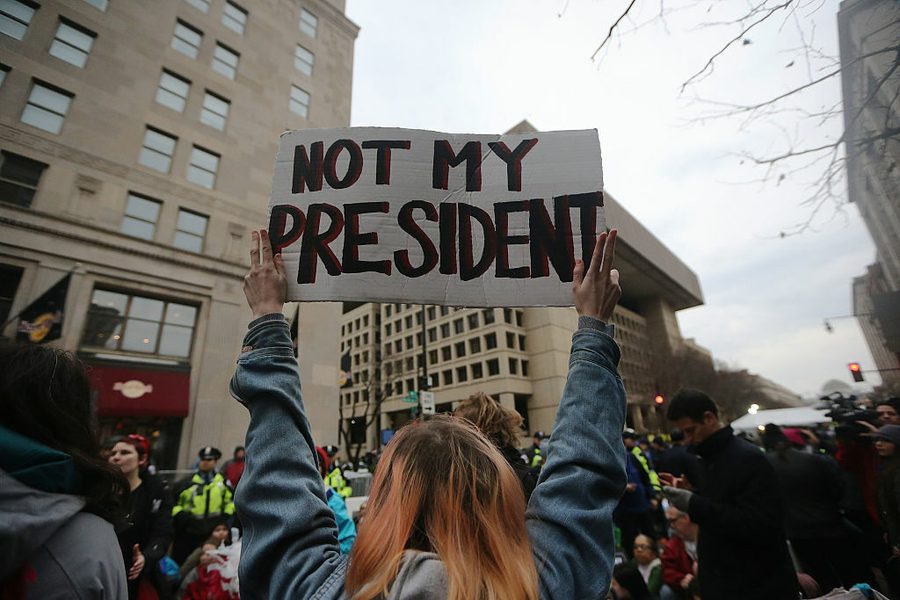Disruption Is Good—Starting with the Inauguration
This weekend’s protests are just the beginning.
Kate Aronoff

There’s another kind of inauguration happening in Washington D.C. today. There’s no ticket needed to get in or balls commemorating it. As Donald Trump gets sworn in as the United States’ 45th president, those opposed to his agenda — especially those most likely to come under attack — are kicking off his tenure with resistance.
Early this morning, at a series of checkpoints and intersections around the inauguration stage, groups representing everything from the movement for black lives to a feminist future and climate justice are attempting to block people from reaching the inauguration stage or — at the very least — show their distaste for what’s happening. On Saturday, the Women’s March will bring hundreds of thousands of people to the Capitol and thousands more out to satellite demonstrations around the city.
“If people don’t organize and mobilize together, they are vulnerable. And we’ll see the unravelling of what this country was built on: the notion that there are freedoms and liberties that people have risked their lives for to come to this country,” says Día Bùi, co-director of the Washington Peace Center and organizer of one of today’s actions. Leading up to Friday’s protests, she and others gathered for trainings and teach-ins at churches and community spaces around the city.
Bùi helped plan a blockade this morning of “communities under attack,” comprised largely of immigrants, Muslims and Jews. Disrupt J20 more generally, she tells In These Times, was initiated by longtime organizers in Washington, D.C., eager not to have the concerns of the people who live in the city — particularly low-income communities and communities of color — left out of the story told about who’s resisting Trump, especially in his own backyard.
About 140 people marched toward a checkpoint, shouting out chants like, “Say it loud, say it clear. Refugees are welcome here!” Members of Showing up for Racial Justice (SURJ) were tasked with interfacing with Trump supporters, though relatively few passed by.
Asked why she’s come to Washington, Melissa Miles, of Newark, New Jersey’s Ironbound Community Corporation, says, “To visibilize us. They want to bury, but we’re seeds. We’re going to sprout and grow. The shit they’re throwing at us is going to be the fertilizer.”
She’ll participate in the Women’s March as part of the It Takes Roots contingent, one of many heading to the march being headed up by grassroots organizers from African-American, Latino, Asian, Pacific Islander, indigenous and poor white communities around the country. “More than ever, this is a moment to come out of our comfort zone, leave our fears behind and really stand up,” Miles told In These Times.
It’s not just that people are resisting Trump, she says, but how. Progressive groups across the spectrum faced an influx of calls and interest almost immediately post-election, and — for many — this weekend’s protests will feed into longer-term organizing. Both Miles and Bùi hope to capitalize on the momentum generated by Trump’s election and see this weekend’s demonstrations as part of a much larger effort.
Because of the fusion of misogyny and racism that Trump’s Cabinet represents, Miles argues, taking leadership from the people and communities most likely to come under increased threat because of the Trump administration is a move that’s as strategic as it is solidaristic.
The narrative that protests are the domain of well-off, sign-sporting college students is a convenient one for Trump. But the history of protest in the United States — from the labor militancy of the 1930s to the civil rights movement to ACT UP — is one that’s been led most fiercely by the people bearing the brunt of regressive policies. Ignoring that risks muting the fact that there is real resistance to Trump, a president who didn’t win the majority of the popular vote and doesn’t have the majority of the country’s support.
Complimenting history’s big and successful demonstrations, too, has always been the less glamorous work of organizing that’s won major egalitarian and redistributive reforms. The same has been true of the right, which lifted its own traditions of organizing from the left. The “handbook” of the Tea Party, famously, was Saul Alinsky’s Rules for Radicals: A Pragmatic Primer for Realistic Radicals, inspired partially by communist organizers in the Congress of Industrial Organizations (CIO).
“The protest is a mechanism for us to bring people together,” Bùi says, “and send the message to an administration, which has already shown that it’s not interested in hearing directly from the people.”
Whether he wants to or not, Trump will hear from them today.
Kate Aronoff is a staff writer at The New Republic and author of Overheated: How Capitalism Broke the Planet — And How We Fight Back. She is co-author of A Planet To Win: Why We Need a Green New Deal and co-editor of We Own the Future: Democratic Socialism—American Style. Follow her on Twitter @katearonoff.







